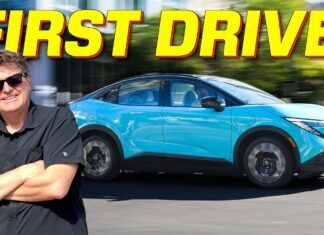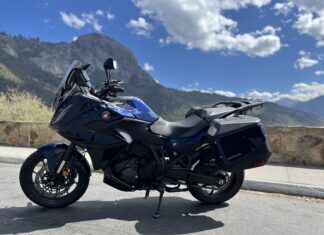If you can handle some decontenting, the new less expensive Model 3 and Model Y Standard have arrived.
It’s not quite the $25K car Tesla touted a few years back, but in an age where everything is now eye-wateringly expensive…hey, take what you can get, right? That’s what we have here with two “new” Tesla models: the Model 3 Standard and the Model Y Standard. After CEO Elon Musk teased the Y’s make-under back in July, we have our first official looks and details (including prices) to ponder.
With these new cars, the EV maker is taking a bit more of a conventional car approach to its naming scheme. And it’s a good change, in my opinion, since you’ll now have these Standard models, the Premium in the middle (formerly the Long Range), and the Performance at the top of the stack.
What makes the Model Y Standard different?
Right off the bat, you can see one of the biggest differences between the upper Model Y versions and this Standard model: no full-width light bar. That’s a relatively minor omission, in the grand scheme of things, though Tesla also cut down some other features in pursuit of a cheaper variant.
Wheels are a common target for cost-cutting, and here you get a standard set of 18-inch wheels to start things off. 19-inch wheels are optional, though even the entry size is still pretty reasonable for a “base model” car. The ride tends to be a little nicer thanks to having some extra sidewall against, say, 21-inch units, so that may actually be a benefit for some. Unlike the Premium and Performance, the Model Y Standard is only available in three colors: white, black or gray. So, not particularly lively options there.
On the inside, you trade full vegan leather seats for a mix of leather and textile inserts. Speaking of the seats, the front ones lose their ventilation, and the rear ones are no longer heated. The steering wheel adjusts manually, the center console design is largely just an open space now (though you still get cupholders and a small console between the seats). The rear 8-inch screen also goes bye-bye in favor of some HVAC vents, but the main 15.4-inch touchscreen remains in place — the Standard doesn’t skimp there, like several other base models do.
Here’s the weird part, though: You still get a glass roof…except you don’t. On the outside, the panoramic glass is still there, but the interior gets a full headliner with some sound deadening material sandwiched between the liner and the glass. So, as an occupant, you don’t get a glass roof…Tesla says that was cheaper than designing and sending some Model Ys down the production line with a fixed metal roof and no overhead glass.
The powertrain is less potent, and there’s a smaller battery, too
On the powertrain side, the Tesla Model Y Standard rocks a single electric motor — no surprises there. Not only that, but it puts out 300 horsepower, so it’s a bit less potent than the one you’ll get in the Premium RWD. Still, the Standard can at least get out of its own way. It’s not super quick with a 6.8-second 0-to-60 (the Premium will do it in 5.4), but it’s enough. And that’s all most folks shopping at this end of the market are likely to ask for, anyway.
The battery gets a slight shave off its cell count for a total usable capacity of 69.5 kWh. That’s good enough for 321 miles of range (still decent by modern EV measurements), dropping to 303 miles if you opt for the 19-inch wheels. It can still plug into a Tesla Supercharger, of course, though the maximum DC fast-charge rate also drops a bit to 225 kW, instead of 250 kW.
What about the Model 3 Standard?
Now, unlike the Model Y Juniper, the Model 3 Highland already lacked a full-width light bar, even on the higher-end variants. So the exterior changes here are more subtle as a result. The 18-inch wheels again set the baseline here, and you can get optional 19s here too, just like you can on the Y. Also like the Y, you can only get the Model 3 Standard in white, black or gray. From what I’ve seen, most of you tend to go in a monochromatic direction anyway, so the relative lack of choice may be no major loss.
It’s the same deal for the Model 3’s interior, broadly speaking, though you do actually get a turn signal stalk here (as you also get on the Y). You also still get the glass roof, weirdly.
The battery also gets pared down to 69.5-kWh here, with an estimated range of 321 miles on the 18s, and 303 miles with the 19s. Go figure. While the Y puts out a flat 300 horsepower, the Model 3 apparently makes 286, which makes it good for 0-60 in 5.8 seconds. That said, such an acceleration time is significantly quicker than the Y with not much less power (and the 3 isn’t that much lighter). The Premium RWD also claims a 0-60 time of 4.9 seconds and doesn’t, as far as we know, make any more power. Color me skeptical here.
Pricing and availability
Tesla says the Model Y Standard will be available first, with initial deliveries kicking off next month into December. The Model 3 Standard, on the other hand, will initially be available in December, stretching into January 2026.
Then there’s the ultimate question: pricing. Keep in mind, the $7,500 federal EV tax credit is no longer available, though some states may still offer incentives of their own. As far as MSRP is concerned, Tesla is currently pricing the Model 3 Standard at $38,630 — about $5,500 less expensive than the Premium.
If you’re shopping the Model Y Standard, you can expect to pay $41,630 ($5K under the Premium), before you add on any options.
























